2006: Published!
January started off with a nasty storm of freezing rain and our patio and driveway were a glare of ice. I had needed to make a trip to the grocery store, but that was out of the question. So I baked some oatmeal bread, we had a few eggs left, and we had some bacon, lots of canned goods, and we would get by until conditions got better, which they did in a few days!
Outside of attending the South East Minnesota Annual Sheep Day, having the final APHIS inspection of my sheep flock, and achieving a Certified Scrapie Free Flock status, there was not much excitement in January.
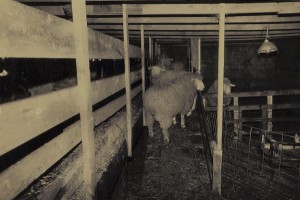
However, there was plenty to occupy my time, as I was cleaning the dreaded barn ramp. A hateful job, which was put off as long as possible! It was the only part of the barn which still had to be cleaned by hand labor, and it really needed the services of some dwarves. But since dwarves are highly unavailable in this area, it falls to the shortest individual in the vicinity, namely me, to do the cleaning.
Truth be told, it is my own fault, as I was the one who decided to have this ramp built to facilitate the feeding of sheep on both sides of a manger, thereby feeding twice as many sheep in the same space without making the actual barn bigger. The ramp however, extends out under a hay loft above it, which provides plenty of head space for sheep, but humans can only traverse it by bending at a right angle from the hips. Can you imagine what that does to your back, especially when you are shoveling manure? As they say, “If it doesn’t kill you, it will make you stronger!” Oh, yeah!
Early in February I brought the sheep in from the lot inside the windbreak, so they would be nice and dry for shearing day in mid-month. We had been having a lot of wet miserable weather, but by shearing day we got our winter in earnest! Talk about an icebox! I felt so sorry for my newly shorn sheep, shivering without their fur coats, but they did put out a lot of body heat, which helped warm the barn somewhat.
My water tank heater went crazy and scorched a hole in the fiber glass tank. At that point, I was stuck with filling 5-gallon buckets, which froze solid in about 10 minutes. Such fun!
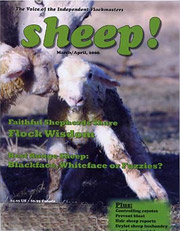 We struggled through February, but March started on a happy note, when Sheep! magazine published my smart sheep story, “Bordering on Genius,” in the March/April issue! Lambing began in mid-month, with 2 sets of triplets, and a set of twins… a good start! A few days later the editor of our county paper came out and did an interview and tour of the lambing barn for an article which was published the following week.
We struggled through February, but March started on a happy note, when Sheep! magazine published my smart sheep story, “Bordering on Genius,” in the March/April issue! Lambing began in mid-month, with 2 sets of triplets, and a set of twins… a good start! A few days later the editor of our county paper came out and did an interview and tour of the lambing barn for an article which was published the following week.
Late in March my brother, Vernon, passed away at the age of 88. He was a pastor in Storm Lake, Iowa, and had served as a chaplain during World War II, crossing the Atlantic and Pacific Oceans thirty-six times during the war.
Lambing ended on April 7; the ewe with the huge teats came in with a nice set of twins, but her teats needed milking out several times to get them down to a size where the lambs could nurse. We finished with a 209% lambing rate that year, down just a bit from the previous year.
Our South East Minnesota Sheep Association held its Spring Farm Tour near Chatfield on the 8th of April. It included a book signing by one of our members who had just recently published a book – soon to be a best seller – about sheep farming: Hit By a Farm. (I was in the book, as I had sold the couple their first 50 ewe lambs!)
The following morning my new Alpaca was delivered. Since the demise of Frisco the llama last year I had been in need of a new flock guardian. My faithful old guard dog, Sheba was aged and arthritic, and had been pretty much retired from active duty. So I was in hopes that Red Rover, the new flock guardian, would fill the bill, and keep our flock safe! He was a real charmer and bonded with the sheep immediately!
Also that week an APHIS veterinarian came to genotype ram lambs for the Scrapie genes. He drew blood samples from 10 lambs that would be kept as rams and ear-tagged them with the official Scrapie ID tags. I was hoping that we would get at least one with the “R” (resistant) gene! A couple days later in the week I headed to the Farm Service Agency to re-enroll my CRP land for another 10 years.
Finally, on April 22 I turned the ewes and lambs out on pasture… what a relief! So good to be out of the barn again!
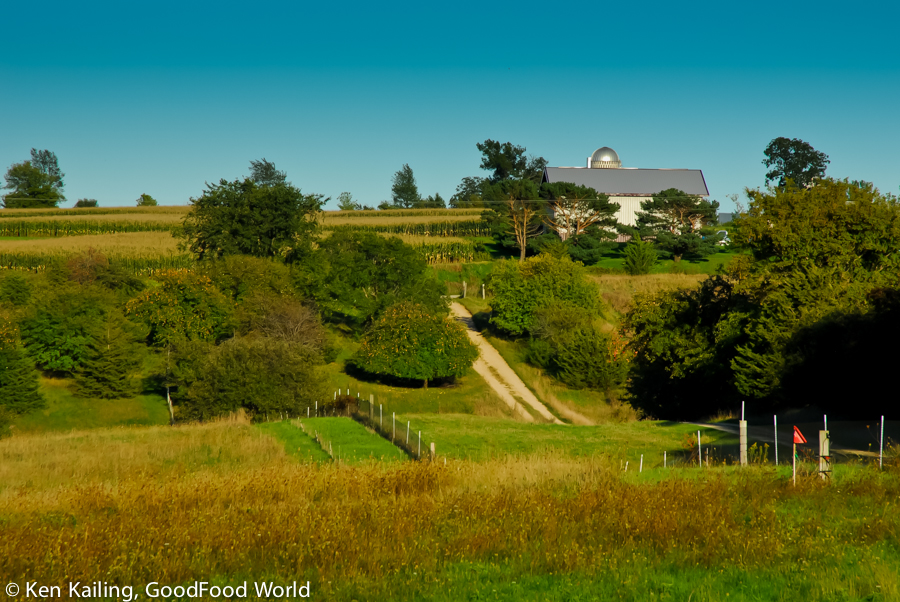
I started off the month of May by doing the Defensive Driving Course offered periodically by our Community Education Program. It was quite ironic, since I had long since given up night driving, that the session started at 6:30 p.m. and did not end until 9:30 p.m., by which time it was, of course, very dark. I had a quite scary time getting home safely, and put my life and those of others at risk. Not ever doing that again!
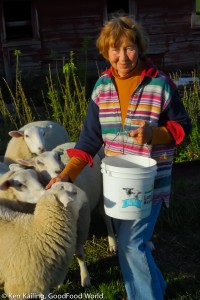 On a happy note, there were weekly trips with friends to the Alpine Nursery, a few miles down the road, to load up on decorative plants for the new retaining walls, as well as plants for the veggie garden… a favorite time of the year!
On a happy note, there were weekly trips with friends to the Alpine Nursery, a few miles down the road, to load up on decorative plants for the new retaining walls, as well as plants for the veggie garden… a favorite time of the year!
With the warmth of June, it was time to treat the entire sheep flock to fend off parasites and to give Red Rover a preventative shot of Ivermectin to forestall an attack by the meningeal parasite which had attacked our previous guard animal, Frisco the llama, and very nearly laid him low! With treatment, he survived, but always walked somewhat out of kilter, although he could run as well as ever.
Two weeks later I re-treated all the lambs for parasites, and also gave them all an enterotoxemia shot to avoid “overeating disease” when they started eating grain after weaning. The rest of the time I dug, planted, hoed, mowed, and generally enjoyed myself!
During the summer, with plenty of moisture, which seemed to be very good for the parasites, but not so good for the grazing ruminants, I was constantly on guard, and every three weeks giving another round of shots to try and protect Red Rover from attack by the meningeal parasite. The parasite is hosted by deer and snails, both of which are prevalent in our area, and it can be picked up by any grazing animal. However, the camelids, llamas and alpacas are exotic animals that have not developed resistance to the parasites in our area, and they are very susceptible to attack. Constant preventative treatment is necessary, but even that is not always successful.
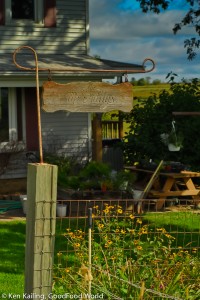 Through August the canning, freezing, and pickle-making was in full swing as the garden’s largesse reached its peak and that, along with continuing treatments for Red Rover, kept me plenty busy. The sale of the feeder lambs during the month helped ease the load a bit, with fewer animals to worry about.
Through August the canning, freezing, and pickle-making was in full swing as the garden’s largesse reached its peak and that, along with continuing treatments for Red Rover, kept me plenty busy. The sale of the feeder lambs during the month helped ease the load a bit, with fewer animals to worry about.
Finally, September arrived and I celebrated my 80th birthday! Now, I could do exactly as I pleased, or so I had once been told by an older brother when he reached that blissful age! However, I found that premise did not work for me. What with the continual re-treatment of Red Rover, working on my friend Kevin Kelleher’s campaign for the Minnesota State Senate, canning pears, picking apples, selling ram lambs, and all the other chores, there was not enough time for “Doing as I pleased!”
Also, in September we were hit by torrential rains – 19″ of rain in one night alone – which led to a devastating flood over a large area of southeast Minnesota. In the wake of the storm, many roads were washed out, so travel was challenging but we did manage to get around despite the difficulties.
Then it was mid-October… time to turn the ram out with the ewes, and Levi, my Amish friend from Iowa, came for another 25 ewe lambs and a ram lamb. I again treated Red Rover to ward off the parasites.
Despite all the preventative treatments, Red Rover was stricken by the meningeal parasite on November 22. I treated him with 2 cc. Ivermectin, 1 1/2 cc. Banamine, 3 grams Panacur. Two days later I repeated those treatments. On Nov. 29, I gave 3 cc. Dexamethasone and repeated that on Nov. 30.
By Dec. 1st, Red Rover was beginning to stand for short periods, by the 4th, he was starting to move about quite a bit and eating well. By the 8th he was moving about very well and looking pretty much back to normal. By the 14th it looked like he would be able to go back with the ewe flock when they came in off pasture.
